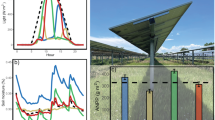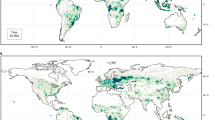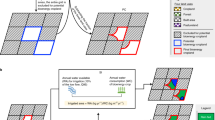Abstract
The vulnerabilities of our food, energy and water systems to projected climatic change make building resilience in renewable energy and food production a fundamental challenge. We investigate a novel approach to solve this problem by creating a hybrid of colocated agriculture and solar photovoltaic (PV) infrastructure. We take an integrative approach—monitoring microclimatic conditions, PV panel temperature, soil moisture and irrigation water use, plant ecophysiological function and plant biomass production within this ‘agrivoltaics’ ecosystem and in traditional PV installations and agricultural settings to quantify trade-offs. We find that shading by the PV panels provides multiple additive and synergistic benefits, including reduced plant drought stress, greater food production and reduced PV panel heat stress. The results presented here provide a foundation and motivation for future explorations towards the resilience of food and energy systems under the future projected increased environmental stress involving heat and drought.
This is a preview of subscription content, access via your institution
Access options
Access Nature and 54 other Nature Portfolio journals
Get Nature+, our best-value online-access subscription
$29.99 / 30 days
cancel any time
Subscribe to this journal
Receive 12 digital issues and online access to articles
$119.00 per year
only $9.92 per issue
Buy this article
- Purchase on Springer Link
- Instant access to full article PDF
Prices may be subject to local taxes which are calculated during checkout

Illustration modified from ref. 49, Springer Nature Ltd.





Similar content being viewed by others
Data availability
The data that support the findings of this study are available from the corresponding author on request.
References
Beckman, J. & Xiarchos, I. M. Why are Californian farmers adopting more (and larger) renewable energy operations? Renew. Energy 55, 322–330 (2013).
Hernandez, R. R. et al. Environmental impacts of utility-scale solar energy. Renew. Sustain. Energy Rev. 29, 766–779 (2014).
Hernandez, R. R., Hoffacker, M. K. & Field, C. B. Land-use efficiency of big solar. Environ. Sci. Technol. 48, 1315–1323 (2014).
Renewables 2014 Global Status Report (REN21 Secretariat, 2014).
Hoffacker, M. K., Allen, M. F. & Hernandez, R. R. Land-sparing opportunities for solar energy development in agricultural landscapes: a case study of the great Central Valley, CA, United States. Environ. Sci. Technol. 51, 14472–14482 (2017).
Trainor, A. M., McDonald, R. I. & Fargione, J. Energy sprawl is the largest driver of land use change in United States. PLoS ONE 11, 7896–7906 (2016).
Bazilian, M. et al. Considering the energy, water and food nexus: towards an integrated modelling approach. Energy Policy 39, 7896–7906 (2011).
Albrecht, T. R., Crootof, A. & Scott, C. A. The water-energy-food nexus: a systematic review of methods for nexus assessment. Environ. Res. Lett. 13, 043002 (2018).
Harwood, S. A. In search of a (WEF) nexus approach. Environ. Sci. Policy 83, 79–85 (2018).
Biggs, E. M. et al. Sustainable development and the water-energy-food nexus: a perspective on livelihoods. Environ. Sci. Policy 54, 389–397 (2015).
Bogardi, J. J. et al. Water security for a planet under pressure: interconnected challenges of a changing world call for sustainable solutions. Curr. Opin. Environ. Sustain. 4, 35–43 (2012).
Dupraz, C. et al. Combining solar photovoltaic panels and food crops for optimising land use: towards new agrivoltaic schemes. Renew. Energy 36, 2725–2732 (2011).
Jaeger, W. K. et al. Finding water scarcity amid abundance using human-natural system models. Proc. Natl Acad. Sci. USA 114, 11884–11889 (2017).
Lobell, D. B., Schlenker, W. & Costa-Roberts, J. Climate trends and global crop production since 1980. Science 333, 616–620 (2011).
Elliott, J. et al. Constraints and potentials of future irrigation water availability on agricultural production under climate change. Proc. Natl Acad. Sci. USA 111, 3239–3244 (2014).
Liu, J. et al. Achieving sustainable irrigation water withdrawals: global impacts on food security and land use. Environ. Res. Lett. 12, 104009 (2017).
Bradford, J. B. et al. Future soil moisture and temperature extremes imply expanding suitability for rainfed agriculture in temperate drylands. Sci. Rep. 7, 12923 (2017).
Kasler, D. More California farmland could vanish as water shortages loom beyond drought. The Sacramento Bee (26 November 2015).
Waha, K. et al. Climate change impacts in the Middle East and Northern Africa (MENA) region and their implications for vulnerable population groups. Reg. Environ. Change 17, 1623–1638 (2017).
Reyer, C. P. O. et al. Climate change impacts in Latin America and the Caribbean and their implications for development. Reg. Environ. Change 17, 1601–1621 (2017).
Tumbo, S. D. et al. Impact of projected climate change on agricultural production in semi-arid areas of Tanzania: a case of same district. Afr. Crop Sci. J. 20, 453–463 (2012).
Adhikari Umesh, N., Pouyan, A. & Woznicki, S. A. Climate change and eastern Africa: a review of impact on major crops. Food Energy Secur. 4, 110–132 (2015).
Knox, J., Hess, T., Daccache, A. & Wheeler, T. Climate change impacts on crop productivity in Africa and South Asia. Environ. Res. Lett. 7, 034032 (2012).
Schlenker, W. & Lobell, D. B. Robust negative impacts of climate change on African agriculture. Environ. Res. Lett. 5, 014010 (2010).
Jiménez Cisneros, B. E. et al. in Climate Change 2014: Impacts, Adaptation, and Vulnerability (eds Field, C. B. et al.) Ch. 3, 229–269 (IPCC, Cambridge Univ. Press, 2014).
Bevan, G. Renewable energy and climate change. Significance 9, 8–12 (2012).
Jaglom, W. S. et al. Assessment of projected temperature impacts from climate change on the U.S. electric power sector using the Integrated Planning Model. Energy Policy 73, 524–539 (2014).
Gonzalez-Diaz, A. et al. Effect of the ambient conditions on gas turbine combined cycle power plants with post-combustion CO2 capture. Energy 134, 221–233 (2017).
Hamlet, A. F., Lee, S.-Y., Mickelson, K. E. B. & Elsner, M. M. Effects of projected climate change on energy supply and demand in the Pacific Northwest and Washington State. Clim. Change 102, 103–128 (2010).
Turner, S. W. D., Ng, J. Y. & Galelli, S. Examining global electricity supply vulnerability to climate change using a high-fidelity hydropower dam model. Sci. Total Environ. 590, 663–675 (2017).
Madani, K. & Lund, J. R. Estimated impacts of climate warming on California’s high-elevation hydropower. Clim. Change 102, 521–538 (2010).
U.S. Energy Sector Vulnerabilities to Climate Change and Extreme Weather (United States Department of Energy, 2013).
Rogers, J. et al. Water-Smart Power: Strengthening the U.S. Electricity System in a Warming World (2013).
Macknick, J. et al. Water and Climate Impacts on Power System Operations: The Importance of Cooling Systems and Demand Response Measures (2016).
van Vliet, M. T. H., Wiberg, D., Leduc, S. & Riahi, K. Power-generation system vulnerability and adaptation to changes in climate and water resources. Nat. Clim. Change 6, 375–380 (2016).
van Vliet, M. T. H. et al. Vulnerability of US and European electricity supply to climate change. Nat. Clim. Change 2, 676–681 (2012).
Liu, L., Hejazi, M., Li, H., Forman, B. & Zhang, X. Vulnerability of US thermoelectric power generation to climate change when incorporating state-level environmental regulations. Nat. Energy 2, 17109 (2017).
Miara, A. et al. Climate and water resource change impacts and adaptation potential for US power supply. Nat. Clim. Change 7, 793–798 (2017).
IPCC Special Report on Renewable Energy Sources and Climate Change Mitigation (IPCC Working Group III, Cambridge Univ. Press, 2011).
US Energy Information Administration June 2016 Monthly Energy Review U.S. Department of Energy (Office of Energy Statistics, 2016).
Bazilian, M. et al. Re-considering the economics of photovoltaic power. Renew. Energy 53, 329–338 (2013).
SunShot Vision Study, DOE/GO-102012-3037 (US Department of Energy, 2012).
Hartmann, H. M. et al. Understanding Emerging Impacts and Requirements Related to Utility-scale Solar Development (US Department of Energy, 2016).
Roberts, B. J. Solar Production Potential across the United States (Department of Energy, National Renewable Energy Laboratory, 2012).
Brown, P. & Whitney, G. U.S. Renewable Electricity Generation: Resources and Challenges (Congressional Research Service, 2011).
Kaldellis, J. K., Kapsali, M. & Kavadias, K. A. Temperature and wind speed impact on the efficiency of PV installations. Experience obtained from outdoor measurements in Greece. Renew. Energy 66, 612–624 (2014).
Said, S. A. M., Hassan, G., Walwil, H. M. & Al-Aqeeli, N. The effect of environmental factors and dust accumulation on photovoltaic modules and dust-accumulation mitigation strategies. Renew. Sustain. Energy Rev. 82, 743–760 (2018).
Cronin, A. et al. Measuring degradation rates of PV systems without irradiance data. Prog. Photovolt. 22, 851–862 (2014).
Barron-Gafford, G. A. et al. The solar heat island effect: larger solar power plants increase local temperatures. Sci. Rep. 6, 35070 (2016).
Solecki, W. D. et al. Mitigation of the heat island effect in urban New Jersey. Environ. Hazards 6, 39–49 (2005).
Campbell, G. S. & Norman, J. M. An Introduction to Environmental Biophysics 2nd edn (Springer, 1998).
Breshears, D. D. The grassland-forest continuum: trends in ecosystem properties for woody plant mosaics? Front. Ecol. Environ. 4, 96–104 (2006).
Hobbs, R. J. et al. Novel ecosystems: theoretical and management aspects of the new ecological world order. Glob. Ecol. Biogeogr. 15, 1–7 (2006).
Hobbs, R. J., Higgs, E. & Harris, J. A. Novel ecosystems: implications for conservation and restoration. Trends Ecol. Evol. 24, 599–605 (2009).
Standish, R., Hobbs, R. J. & Miller, J. Improving city life: options for ecological restoration in urban landscapes and how these influence interactions between humans and nature. Landsc. Ecol. 28, 1213–1221 (2012).
Nabhan, G. P. Our Coming Food Crisis. New York Times http://www.nytimes.com/2013/07/22/opinion/our-coming-food-crisis.html (21 July 2013).
Nabhan, G. P. Growing Food in a Hotter, Drier Land: Lessons from Desert Farmers on Adapting to Climate Uncertainty (Chelsea Green Publishing, 2013).
Ravi, S. et al. Colocation opportunities for large solar infrastructures and agriculture in drylands. Appl. Energy 165, 383–392 (2016).
Amaducci, S., Yin, X. & Colauzzi, M. Agrivoltaic systems to optimise land use for electric energy production. Appl. Energy 220, 545–561 (2018).
Aroca-Delgado, R., Perez-Alonso, J., Jesus Callejon-Ferre, A. & Velazquez-Marti, B. Compatibility between crops and solar panels: an overview from shading systems. Sustainability 10, 743 (2018).
Valle, B. et al. Increasing the total productivity of a land by combining mobile photovoltaic panels and food crops. Appl. Energy 206, 1495–1507 (2017).
Macknick, J., Beatty, B. & Hill, G. Overview of Opportunities for Co-Location of Solar Energy Technologies and Vegetation (National Renewable Energy Laboratory, 2013).
Majumdar, D. & Pasqualetti, M. J. Dual use of agricultural land: introducing ‘agrivoltaics’ in Phoenix Metropolitan Statistical Area, USA. Landsc. Urban Plan. 170, 150–168 (2018).
Dinesh, H. & Pearce, J. M. The potential of agrivoltaic systems. Renew. Sustain. Energy Rev. 54, 299–308 (2016).
Goetzberger, A. & Zastrow, A. On the coexistence of solar-energy conversion and plant cultivation. Int. J. Sol. Energy 1, 55–69 (1982).
Marrou, H., Wery, J., Dufour, L. & Dupraz, C. Productivity and radiation use efficiency of lettuces grown in the partial shade of photovoltaic panels. Eur. J. Agron. 44, 54–66 (2013).
Adeh, E. H., Selker, J. S. & Higgins, C. W. Remarkable agrivoltaic influence on soil moisture, micrometeorology and water-use efficiency. PLoS ONE 13, e0203256 (2018).
Marrou, H., Dufour, L. & Wery, J. How does a shelter of solar panels influence water flows in a soil-crop system? Eur. J. Agron. 50, 38–51 (2013).
Marrou, H., Guilioni, L., Dufour, L., Dupraz, C. & Wery, J. Microclimate under agrivoltaic systems: is crop growth rate affected in the partial shade of solar panels? Agric. For. Meteorol. 177, 117–132 (2013).
López-España, R. G. et al. Geographical differentiation of wild pepper (Capsicum annuum L. var. glabriusculum) populations from northwestern Mexico. Phyton 85, 131–141 (2016).
Bosland, P. & Votava, E. Peppers: Vegetable and Spice Capsicums (CABI Publishing, 2000).
Coutts, A. M., Tapper, N. J., Beringer, J., Loughnan, M. & Demuzere, M. Watering our cities: the capacity for water sensitive urban design to support urban cooling and improve human thermal comfort in the Australian context. Prog. Phys. Geogr. 37, 2–28 (2013).
Luong, T. M. et al. The more extreme nature of North American monsoon precipitation in the Southwestern United States as revealed by a historical climatology of simulated severe weather events. J. Appl. Meteorol. Climatol. 56, 2509–2529 (2017).
Schmidt, M., Jochheim, H., Kersebaum, K.-C., Lischeid, G. & Nendel, C. Gradients of microclimate, carbon and nitrogen in transition zones of fragmented landscapes—a review. Agric. For. Meteorol. 232, 659–671 (2017).
Martinez, M. A., Andujar, J. M. & Enrique, J. M. Temperature measurement in PV facilities on a per-panel scale. Sensors 14, 13308–13323 (2014).
Blair, N. et al. System Advisor Model (SAM) General Description (Version 2017.9.5) (National Renewable Energy Laboratory, 2018).
Blair, N. et al. System Advisor Model, SAM 2014.1.14: General Description (National Renewable Energy Laboratory, 2014).
Barron-Gafford, G. A. et al. Impacts of hydraulic redistribution on grass-tree competition vs facilitation in a semi-arid savanna. New Phytol. 215, 1451–1461 (2017).
Hamerlynck, E. P., Scott, R. L. & Barron-Gafford, G. A. Consequences of cool-season drought-induced plant mortality to Chihuahuan Desert grassland ecosystem and soil respiration dynamics. Ecosystems 16, 1178–1191 (2013).
von Caemmerer, S. & Farquhar, G. D. Some relationships between the biochemistry of photosynthesis and the gas exchange of leaves. Planta 153, 376–387 (1981).
Barron-Gafford, G. A. et al. Photosynthetic temperature responses of co-occurring desert winter annuals with contrasting resource-use efficiencies and different temporal patterns of resource utilization may allow for species coexistence. J. Arid Environ. 91, 95–103 (2013).
Barron-Gafford, G. A., Scott, R. L., Jenerette, G. D., Hamerlynck, E. P. & Huxman, T. E. Temperature and precipitation controls over leaf- and ecosystem-level CO2 flux along a woody plant encroachment gradient. Glob. Change Biol. 18, 1389–1400 (2012).
Acknowledgements
This research and data were supported by (1) the Water, Environmental, and Energy Solutions initiative at the University of Arizona; (2) the Accelerate For Success Grants Program at the University of Arizona; (3) NSF EAR No. 1659546, REU Site: Earth Systems Research for Environmental Solutions at Biosphere 2; and (4) the Department of Energy’s National Renewable Energy Lab through No. REJ-7-70227, Meeting SunShot Cost and Deployment Targets through Innovative Site Preparation and Impact Reductions on the Environment programme. The authors thank J. Adams and the Biosphere 2 team for their assistance in maintenance of the Biosphere 2 Agrivoltaics Learning Lab.
Author information
Authors and Affiliations
Contributions
G.A.B.-G., R.L.M., L.F.S., I.B.-M., D.T.B. and M.T. established research sites and installed monitoring equipment. G.A.B.-G. directed research. R.L.M., L.F.S., I.B.-M., D.T.B. and M.T. conducted most of the site maintenance. G.A.B.-G., M.A.P.-Z., G.P.N. and J.E.M. led efforts to secure funding for the research. All authors discussed the results and contributed to the manuscript.
Corresponding author
Ethics declarations
Competing interests
The authors declare no competing interests.
Additional information
Publisher’s note: Springer Nature remains neutral with regard to jurisdictional claims in published maps and institutional affiliations.
Supplementary information
Rights and permissions
About this article
Cite this article
Barron-Gafford, G.A., Pavao-Zuckerman, M.A., Minor, R.L. et al. Agrivoltaics provide mutual benefits across the food–energy–water nexus in drylands. Nat Sustain 2, 848–855 (2019). https://doi.org/10.1038/s41893-019-0364-5
Received:
Accepted:
Published:
Issue Date:
DOI: https://doi.org/10.1038/s41893-019-0364-5
This article is cited by
-
Sustainable pathways towards universal renewable electricity access in Africa
Nature Reviews Earth & Environment (2024)
-
Water Footprints and Veganism
The Journal of Value Inquiry (2024)
-
Competing for space? A multi-criteria scenario framework intended to model the energy–biodiversity–land nexus for regional renewable energy planning based on a German case study
Energy, Sustainability and Society (2023)
-
Supplying ecosystem services on US rangelands
Nature Sustainability (2023)
-
Designing plant–transparent agrivoltaics
Scientific Reports (2023)



